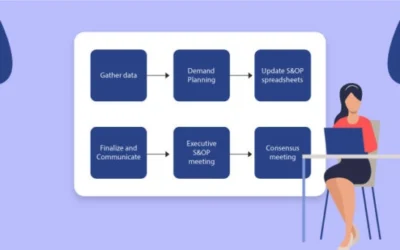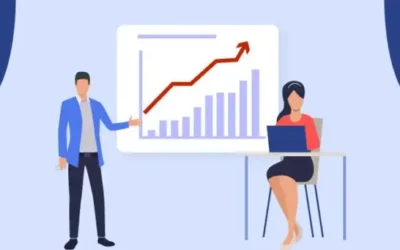What is Sales Pipeline and how to Create it?
The ultimate goal of any business is to bring in sales. However, the process of making customers begins with building a relationship with a stranger. This is not an easy thing but it isn’t impossible either. Successful businesses know the knack. They have a strong sales pipeline to gradually convert a skeptical prospect into a loyal customer.
Studies have proved that firms with optimized pipelines have a 28% higher revenue growth. That is why the term ‘sales pipeline’ is a buzzword in sales circles. It serves as a crucial tool for sales management operations that can significantly increase your bottom line.
So, here is more detailed information on what is a sales pipeline and how to create it.
What is Sales Pipeline?
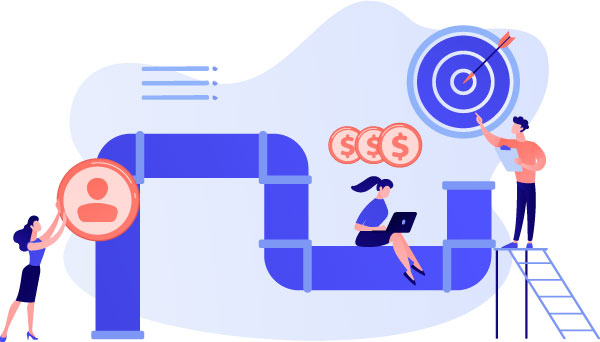
A sales pipeline is a visual representation that shows different stages of the sales process through which multiple prospects of yours are moving through to make a purchase. It provides an overview of sales and hence facilitates sales reps in sales forecasting. It also provides them with a way to track their progress.
As a visual tool, a sales pipeline takes the shape of a funnel or a horizontal bar, segmented into the phases of a company’s sales process. Sales reps move prospects from one stage to the next of the sales process. These stages for instance include the initial contact period, the qualification of a prospect, etc.
Often sales reps juggle around with multiple sales prospects and deals. Having a sales pipeline enables sales reps to see where their efforts, money, and deals are directed at any point in time. This way, they can prevent any prospect or deal from slipping through the cracks.
Thus, a sales pipeline ensures that you aren’t blindly moving forward without any idea of the progress of your sales process and the position of your deals.
How to Create a Sales Pipeline?
Here are the basic steps to create your sales pipeline.
1. Define the stages of your sales pipeline
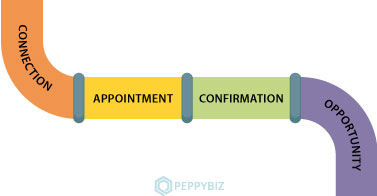
You need to define the different sales pipeline stages to suit your business. Each stage has to match with your prospect’s purchase journey. Typically, prospects go through the following stages

Stage 1- Awareness: Prospects realize that they have an opportunity or pain point.
Stage 2- Consideration: The prospect defines their opportunity or paint point, develops assessment criteria and needs, and investigates available methods.
Stage 3- Decision: The prospects have concluded their strategy and are now weighing up different solutions.
Keeping these stages in mind, you could come up with a sales pipeline with the following stages:
Stage 1- Connection: The prospect connects with your company by subscribing to your newsletter, opening your email, downloading an e-book, or attending a webinar.
Stage 2- Arranging an appointment set: The prospect agrees to a meeting with you online or offline to know about the solution you offer.
Stage 3- Completing the appointment: The prospect attends the meeting, and signals positively toward proceed further.
Stage 4- Accepting the solution: The prospect accepts the solution or opportunity you offer.
The above is a simple outline. If your offering is more complex, the more will be the number of stages and the longer will be your sales cycle.
2. Get to know how long prospects stay in each stage
You need to know how many prospects typically continue through each stage. Count both those won/closed deals as well as those getting through the buyer stages. This will help you recognize some patterns and valuable insights.
For instance, you may find that an average prospect spends two weeks in the accepting the solution stage, while those that ultimately purchase spend three weeks there. Identifying such benchmarks will facilitate your sales reps in figuring out those promising opportunities.
Also, get to know the conversion rate probability per stage. That is the percentage of prospects that usually proceed to the next stage. For instance, you may find that 69% of them are likely to purchase in the demo stage and 80% in the negotiation stage. After this, you can allocate these percentages to each stage, and then come up with estimates of monthly and/or quarterly revenue.
3. Estimate the number of prospects that need to convert at each stage to meet your goals
Now that you have your estimate of revenue you need to generate each month, just work backward to calculate how many prospects you need to convert in each of your pipeline’s stages. You just have to divide your target quarterly or monthly revenue by your average deal size to know the number of deals you need to win in a quarter or month.
Now, divide your target deal number by your conversion rate probability per stage. That is if you have to win 100 deals and your sales reps usually close 80% of deals in the demo stage, 125 prospects must arrive at that stage in a month.
Perform this process for each stage so that you can set goals for your sales reps. The sales reps in turn can use these benchmarks to evaluate their progress against the goal.
4. Trace the similarities between prospects that convert at each of your pipeline’s stages
Now, find out the common attributes of prospects that convert at each stage. Take into account the actions taken by your sales rep and the consequent response from the prospect’s end. Like for instance, when your sales reps send them a follow-up email, your prospects would respond either positively or negatively.
Gather data about those prospects who have responded positively, which may be something like agreeing to attend a demo session. You’ll get to know commonalities between these people. For instance, you may find that most of them belong to the same age group or work in similar job positions.
This implies that people in that category are largely benefitted from the solution you offer and are looking for it. So, in the future, you can direct more of your efforts toward advertising and marketing to that particular section.
This kind of quantification also helps in modeling your goals and comprehending recurring behaviors. You’ll benefit from knowing these as you can apply those to make situations work in your favor.
5. Avoid the sales trap

Oftentimes, salespeople engage a lot in closing deals that they forget to bring in new leads to fill the sales pipeline. They would have prospected intensely for more than six weeks to fill the pipeline to the point where they could make sales. But pitifully, they tend to neglect the activities that generated a full pipeline.
Consequently, at the end of the quarter when all the sales are closed or lost, they would awake to find that there are no more prospects left. The pipeline would have become dry- a pathetic condition referred to as “sales trap”.
Sales reps should consciously avoid this by prospecting to new leads regularly. This will ensure that your sales pipeline is always growing and generates continual revenue.
6. Maintain the health of your pipeline.
You need to set up and adhere to a standard follow-up process all through your sales pipeline. This will ensure that you don’t lose leads. So, provide your team with a system for following up with leads, including timing, contact channel, and pitch.
For instance, it can be as-
- Each inbound lead is got in touch with within 4 hours.
- Each lead receives 8 to 10 touches over a month.
- Each lead is contacted through different channels like phone calls, email, and social media.
- Each contact offers new resources or information to the leads.
This kind of consistent follow-up strategy also enables your sales reps to maintain clean pipelines that inform them when to say goodbye to prospects. If a prospect has not responded (like calling back, picking up your call, etc.) to the last touch, it is time he or she is eliminated from the pipeline.
7. Clean up your pipeline routinely
Regularly cleaning up your pipeline is crucial for precise sales forecasting. The reason behind this is that most forecasts use each prospect’s stage (and not its age) to determine the probability of its close. For instance, if you have made a $500 deal to the prospect a month back but he hasn’t responded since then, it means that he isn’t ready for the deal.
However, since he is in the negotiation stage, which has an 80% close rate, your sales forecast would account for his deal as $450 potential income in the upcoming month. This implies that your sales forecast is $450 off. And each stale deal will widen the rift between sales reality and sales expectations.
This is why you need to clean your pipeline regularly by
- Identifying prospects that are in your pipeline for periods lengthier than your average sales cycle.
- Filtering out and dropping dead leads.
- Sending a sales breakup email to those prospects before you give up on them entirely.
- Ensuring that your data is precise and up-to-date.
- Reviewing your sales pipeline periodically.
A few more best practices to follow
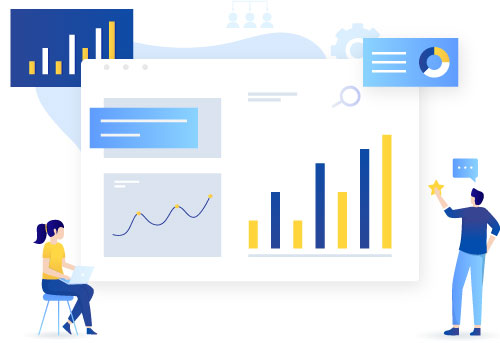
We have covered most of the best practices with regards to making the fullest use of your sales pipeline in the previous section. Here are the left out ones-
- Give your prospects more content to help them comprehend if the solution your offer will add value to their business. This can take the form of blogs, articles, videos, FAQs, infographics, case studies, e-books, video tutorials, white papers, free trials, etc.
- Shorten your sales cycle by giving your prospects more information upfront (to facilitate shortening their decision-making time), reducing the number of days between the follow-ups, etc.
- Review and improve your pipeline processes regularly by running mini sales experiments. You can consider factors like a sales pitch, follow-up frequency, etc. for fine-tuning.
- Use dedicated CRM software to manage your sales. While a CRM with marketing automation will be effective for well-established, large organizations, a simple Excel spreadsheet will do for small firms working on a tight budget.
Wrapping up
Having a sales pipeline is crucial for your business. For, it helps your sales team monitor the progress of their efforts and provides them with a clear idea of what has to be done to boost your firm’s revenue. And enhancing sales outcomes implies more money for the company and for the reps, who earn a commission on each sale they bring.


